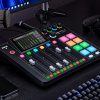
Review: SPL MTC Mk2
SPL’s latest promises powerful and transparent sonic performance across a wide range of I/O.
I’ve always been a fan of SPL gear. The German company consistently releases well-engineered, musically-pleasing equipment and can boast an enviable track record of innovation and reliability. I’ve got one of its Stereo Vitalizers (a wicked piece of kit and dangerous in the wrong hands) permanently installed on a parallel mix bus on my console and over the years have enjoyed many a tweak of its Transient Designer. I’d been looking at monitor controllers for a little while, so the arrival of the MTC Mk2 Monitor and Talkback Controller for review came at the perfect time and I was quick to put it through its paces during a busy few weeks of sessions.
TOP OF THE TABLE
The MTC Mk2 builds on the success of its popular predecessor with the addition of useful functions along with some slight tweaks to the control layout and a quite dramatic colour change. The desktop format is maintained and the unit is quite imposing with its sleek matte black finish and generous 272mm x 275mm footprint. Unlike remote controlled rack units that are designed to be tucked away out of sight, the MTC Mk2 wants to be front and centre, and requires a decent patch of desk space. Being aimed more towards the professional end of the market, the SPL is a good-looking piece of kit that repays proper integration into your setup.
Apart from the two headphone outputs on the front panel, all other I/O is tucked away at the rear of the unit, so a tidy workspace look is easy to achieve. Much like the earlier model, the MTC Mk2 features a smartly-raked front panel that gives the user optimised ergonomics and clear visual information thanks to strong white legending and a raft of push button switches along the top with indicators that illuminate when the various functions are engaged.
Centre stage is a lovely large rotary controller for master volume control with a smooth velvety feel. Smaller, softly-stepped rotary controls either side of this dial-in talkback level, headphone matrix crossfeed, producer and artist headphone volumes.
Along the top of the unit there’s a comprehensive range of switches including all input and monitor selectors plus dedicated polarity, L/R swap, mono, dim and independent mute switches for both speakers and headphones.
On the left-hand side is a built-in microphone plus backlit talkback switch that is routed to the ‘Artist’ headphone output.
Another backlit switch on the right-hand side routes the audio from Input C directly to the ‘Artist’ headphone mix thus providing a discrete monitoring path for the all-important talent.
The switches and controls have a very reassuring pro feel to them and the build quality is outstanding.
NEED TO KNOW
SPL MTC Mk2
Monitor & Talkback Controller

TECH SPECS
The technical specifications make for impressive reading, the highlights include extremely low noise and distortion figures while, being an active unit, the MTC Mk2 can provide a maximum of 22.5dBu gain to any incoming signal.
The headphone amps are a special Class A/B design that deliver wonderful sonics and are quite addictive to listen through.
To top things off, in typical SPL style, it has also introduced something a bit different with the ‘Phonitor Matrix’. If you’re not already familiar, this is essentially a type of spatial processing that can be dialled in via the Crossfeed controller. The effect mimics the sound of speakers while monitoring through headphones and is achieved by applying interaural time delays and attenuation with a fixed ‘opening angle’ of 30 degrees. When the Crossfeed control is turned all the way to the left the effect is disabled. It is particularly recommended for headphone mixing where the focus is on panning and EQ, reverb placements and depth. Not perhaps a mission-critical feature for some but an interesting addition to what is already a very well-endowed unit.

MIX & MATCH
Once patched in, it was an easy process to get the unit operating in mixing and tracking sessions. I was a little disappointed to hear an unmistakable ‘pop’ in the monitors associated with powering up the unit but soon learnt to switch things on in the right order to avoid this. Switching between speakers and sources was painless and noise-free and I really enjoyed making quick contrast assessments on vocal and instrument levels using my Quested VS2108s and my trusty Yamaha NS10s. I even plugged in an old ghetto blaster just for kicks. I also used the mono and polarity switch buttons in tandem for a bit of M/S assessment, another handy capability of the unit.
I found the Phonitor Matrix quite interesting. It does create the impression of a more distant stereo sound source through the headphones but is also subtle enough that key mix decisions can be made without too much concern over translation. I often use headphones to check for buzzes and extraneous noises in the final stages of mixing and I can see that the Phonitor Matrix would be a handy tool in expanding that role to include fine-tuning the placements of certain effects and levels, particularly out wide in the soundstage.
In tracking mode, the MTC Mk2’s talkback mic really came into its own and the generous gain available is powerful enough to stiffen the spine of even the most distracted guitarist or deaf drummer when required. The mechanical noise of engaging the talkback switch is quite loud due to its proximity to the mic, and I did at some points wish for a latch feature on the button for longer conversations. Of course, both these issues are easily addressed by plugging a talkback footswitch into the ¼-inch jack provided.
There’s no dedicated minijack input for smartphones but again a simple adapter cable into one of the rear inputs solves that issue.
The SPL monitor controller lacks the ability to cater to multiple artist headphone mixes so there’s a limitation there, but in tandem with the average DAW output matrix the MTC Mk2 really does scale up the monitoring and headphone control options and is an absolute pleasure to use.
SPECIAL SOURCE
There is no shortage of monitor controllers to choose from so it’s important to assess your needs and find the right fit. In terms of features, the MTC Mk2 offers a pro solution with a healthy complement of I/O and inclusions such as dedicated sub and meter outputs, a talkback footswitch and cue bus routing, as well as an elegant front panel and a lot of dedicated switching. The main volume control is a joy to use and the Phonitor Matrix spices things up in the headphone sends too. Most importantly, the MTC Mk2 delivers beautifully transparent sonics across the board. At no point did I feel there was any extra colouration or sonic degradation at play and I was extremely happy with the results from both a mixing and tracking perspective with the SPL patched in. All my loudspeakers sounded true, and the flexibility and fidelity of the headphone outputs was a real highlight. If you’re looking for a great-sounding and well-endowed monitor controller, the SPL MTC Mk2 has you well and truly covered for both high-end home and professional studio applications.























I own the original version. SPL’s customer service is OUTSTANDING!
I got mine last week. I do like it a lot. The sound quality is nice. Is it worth the $1300 US price? Not sure.